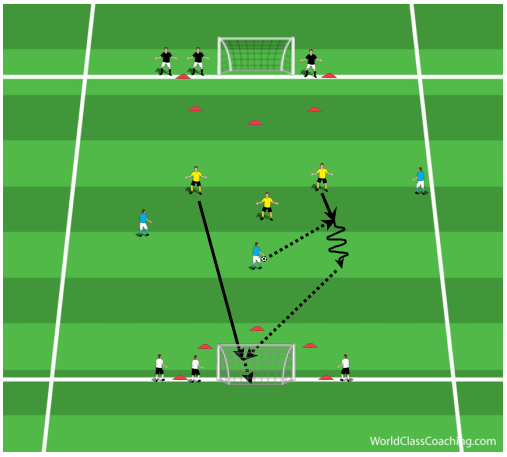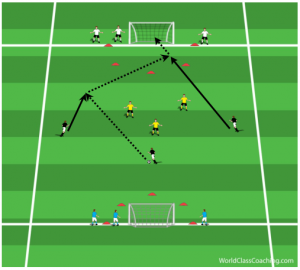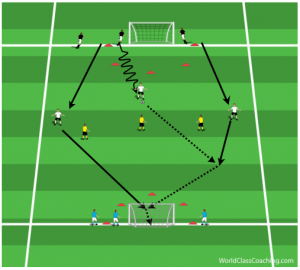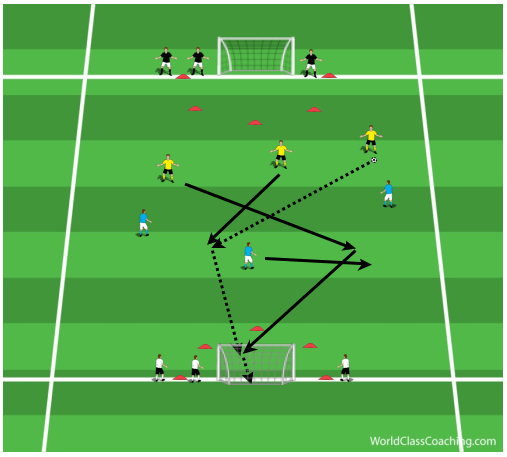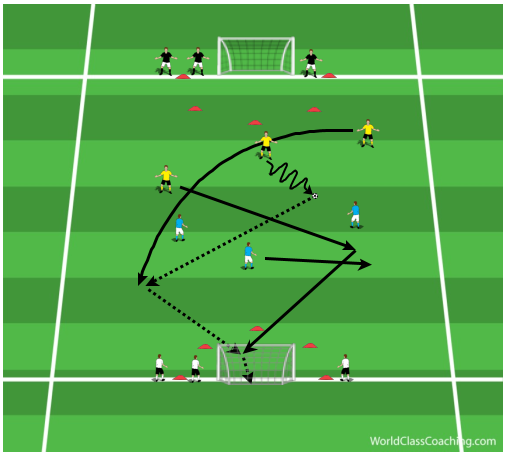By Sean Pearson
Area:40x30 Yards
Players: 12
Teams: 4
Length: 20 mins
This exercise is fast paced and high energy. It needs 4 teams for constant attacking and to give players short rest periods. Throughout the exercise players/teams must be positive and attack together.
Objectives
- To attack with speed and penetration
- Manipulate the positioning of the defenders
- Quick decision making
2 teams of 3 players start at each end of the field, a semi-circle of cones surrounds each goal. 2 teams compete against each other at any one time, one attacks and one defends. A time limit is given between 8-10 seconds to attack the opposite goal.
To score, a team must finish with a one time finish inside the semi-circle of cones. This is to encourage the whole team to attack rather than one player. If the team scores they come off at the end they are attacking. The team waiting at this end has a ball ready and attacks the same team that were defending. The team defending can win the ball and attack themselves meanwhile a new time limit starts.
If a team miss a scoring opportunity they stay on as defenders and the team waiting by the goal attacks them. This is so each team has rest periods and one team isn’t stuck defending. Whichever team kicks the ball out of bounds is the defending team when a new team enters the field to attack.
Phase 1 – Seeing Defender’s Positioning
- Explain to the attacking team to have the player with the ball dribble through the middle and have the other two players get as wide and as high as possible without being offside.
- Depending on defenders positioning:
- If they are all central, pass wide ahead of the player. As the defenders look where the ball goes have the opposite wide player make a run behind the defenders. The ball is then passed into the semi-circle to be scored with a one time finish.
- If the defenders spread out there are now gaps between them to exploit. A wide player runs beyond the line of defenders and the central player times the through pass into the space behind the defenders to coincide with the wide player’s run so they are not offside. Again the opposite wide player continues their run to joins the attack.
- The attack must use speed and penetration through or around the defenders, the time limit forces the team to try to score otherwise they stay on as defenders. This is game realistic as counter attacks use speed to catch teams on the break, if they slow down they give the defending team a chance to get players back behind the ball.
Phase 2 – Manipulating Defender’s Movements
- Attacking players now need to start making diagonal runs instead of straight runs.
- The player with the ball can start to dribble down the side of the field and commit one defender. Have the far wide player make a diagonal run across the central player almost in front of the player with the ball. The central defender will now have a choice to make:
- If they stay centrally the pass is on for the wide player.
- If they move to follow the wide player space opens up for a pass to the central player who has moved into the space left by the central defender.
- Movements across the face of defenders will pull them out of position and can be used as decoys to manipulate the positioning of the opposing team. Gaps begin to appear as one defender follows a runner and another defender stay in position.
- Use overlaps to further manipulate defender’s movements.
- Make sure two players never run into the same space as each other as this will decrease your passing options and allow the defenders to mark two players at once.
Phase 3 – Decision Making
- Allow your players free play to decide for themselves the movements they should make. Their decisions should be based on defender’s positioning and using the information explained in the session to get into the space behind and score.
Variations
- Add a GK
- To increase difficulty play with underloads of 3v4 to replicate game like scenarios where your team would be outnumbered.
Coaching Points
- Understand which player should move where, when and how.
- See what position the defenders are in and use movements and passes to exploit them.
- Attack with speed and penetration.
By Sean Pearson
By Sean Pearson. Sean is also the author Coaching Team Shape in the 3-3-1, Coaching Team Shape in the 4-2-3-1 and Coaching Team Shape in the 4-3-3

